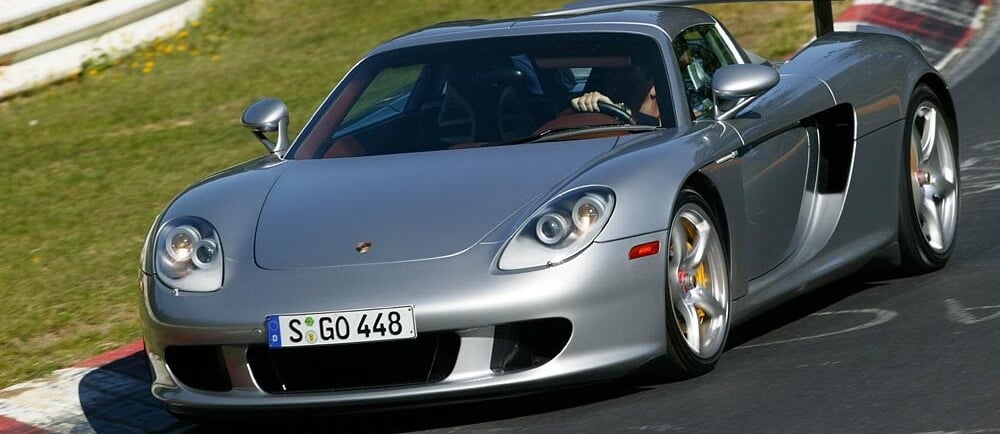Porsche Carrera GT
The Porsche Carrera GT (Project Code 980) is a mid-engine sports car that was manufactured by German automobile manufacturer Porsche from 2004 to 2006.
UBER CARS
Admin
1/29/20256 min read


The Porsche Carrera GT is one of the most iconic supercars of the early 21st century. A blend of breathtaking performance, cutting-edge technology, and timeless design, it was a landmark achievement in automotive engineering. Produced between 2004 and 2006, the Carrera GT combines the precision and craftsmanship of Porsche with the raw power and exhilaration expected from a hypercar. This article delves into the Carrera GT's performance characteristics, its development journey, design features, available options, its competitors, and the most valuable model year for collectors.
The Carrera GT is widely regarded as one of the finest supercars of its era. Powered by a naturally aspirated 5.7-liter V10 engine, the Carrera GT was capable of producing 612 horsepower at 8,000 rpm and 590 Nm (435 lb-ft) of torque at 5,750 rpm. This engine was developed with motorsport experience in mind, and its high-revving nature provided a thrilling driving experience.
Acceleration and Top Speed: With a 0-60 mph time of just 3.5 seconds and a top speed of 205 mph, the Carrera GT is in a league of its own in terms of raw performance. Its acceleration is explosive, with the car capable of reaching 100 mph in just under 6 seconds.
Handling and Suspension: The Carrera GT’s handling was sharpened by an ultra-responsive suspension system, featuring a double wishbone front suspension and a multi-link rear suspension, both made of lightweight aluminum. The car’s dynamic stability management system ensured the car remained planted on the road at high speeds. The car's near-perfect weight distribution (approximately 42% front and 58% rear) provided excellent balance and cornering capabilities.
Braking Performance: One of the standout features of the Carrera GT was its braking system. It was equipped with carbon-ceramic brake rotors (PCCB), a technology typically reserved for motorsport applications. This system not only offered exceptional stopping power but also provided resistance to brake fade under extreme conditions.
The Carrera GT’s development was deeply influenced by Porsche’s motorsport history. Initially conceived in the late 1990s as a racing prototype, the car evolved into a street version after Porsche realized the potential of a road-going hypercar. The development process was intricate, with a focus on both performance and safety. Engineers carefully selected materials, including carbon fiber, for the car's lightweight yet rigid structure, and painstakingly refined the engine to deliver performance without compromise. The Porsche Carrera GT was first unveiled at the 2000 Paris Motor Show as a concept car. At the time, Porsche was looking to create a car that would showcase its engineering and design capabilities. The company assembled a team of engineers and designers, led by Harm Lagaaij, to develop the car. The development process took several years, with the team working tirelessly to refine the car's design and performance. The Carrera GT was finally launched in 2003, with production limited to just 1,270 units.
The heart of the Carrera GT is its engine—a V10 that was initially designed for use in Porsche's Le Mans prototype race car, the Porsche LMP2000. When the project was discontinued, Porsche chose to adapt the engine for use in a production car. The engine was paired with a 6-speed manual transmission, another nod to the car's motorsport pedigree. The Carrera GT's development was further enhanced by Porsche's involvement in Formula 1, with many of the lessons learned in motorsport being directly applied to this street machine.
The Porsche Carrera GT’s design was both functional and visually stunning, reflecting Porsche’s philosophy of form following function. The car’s wide, low stance and aggressive lines emphasized its performance credentials, while its minimalist interior exuded luxury and focus on driving.
Exterior Design: The Carrera GT’s exterior design, conceived by Porsche designer Harm Lagaay, features clean lines, sculpted surfaces, and a wide, imposing rear. The car's rear wing is integrated into the design and can be adjusted to provide optimal downforce at higher speeds. The aerodynamic qualities of the Carrera GT were extensively tested in Porsche’s wind tunnel to ensure maximum efficiency and stability at speed.
Interior Features: Inside, the Carrera GT was designed with a focus on the driver. The seats were made of carbon fiber and leather, while the center console featured a minimalist design. The instrument cluster was dominated by large, easy-to-read tachometers, with a striking gearshift lever reminiscent of racecars. The use of premium materials, including leather and Alcantara, ensured comfort without detracting from the performance-oriented character of the car.
Carbon Fiber Monocoque: One of the defining features of the Carrera GT was its lightweight carbon fiber monocoque. This advanced construction technique made the car incredibly stiff and safe while keeping its weight relatively low for a car of its size and performance capabilities. This monocoque structure also contributed to the car’s perfect balance and exceptional handling.
Innovative Exhaust System: The Carrera GT featured a distinctive quad-pipe exhaust system that not only enhanced its aggressive sound but also contributed to its high-performance capabilities. The exhaust system was designed to optimize the flow of gases, improving engine efficiency.
The Porsche Carrera GT was offered in a range of options and color choices, ensuring that owners could tailor the car to their personal preferences.
Color Options: The Carrera GT was available in a selection of bold and striking colors, including classic Porsche hues like Carrera White, Basalt Black, and Guards Red. There were also more unique options like GT Silver Metallic and a few limited edition colors, making it a desirable choice for enthusiasts and collectors alike.
Interior Options: The interior could be customized with a variety of leather and Alcantara finishes, with contrasting stitching and accent pieces available in colors such as red, yellow, or black. Carbon fiber accents were also a popular choice, enhancing the car’s motorsport-inspired look.
Wheel and Brake Options: The Carrera GT came equipped with forged magnesium alloy wheels, which were both lightweight and strong. Customers could opt for different finishes on the wheels, including polished or satin black. The carbon-ceramic brakes (PCCB), as mentioned earlier, were a standout feature and came standard on the Carrera GT.
Limited Editions: Throughout its production run, Porsche also released a few special edition Carrera GTs with unique configurations and additional features, including the possibility of bespoke colors and interior layouts.
The Carrera GT was launched during a period when other automakers were producing some of the most revered supercars in history. The main competitors to the Porsche Carrera GT included:
Ferrari Enzo (2002-2004): The Ferrari Enzo was one of the Carrera GT’s most direct competitors. Powered by a 6.0-liter V12 engine producing 660 horsepower, the Enzo could achieve a top speed of around 218 mph. The Enzo was more expensive and exclusive, but it lacked the Carrera GT’s purist driving experience, as it came equipped with a semi-automatic transmission.
Mercedes-Benz SLR McLaren (2003-2010): The SLR McLaren was another competitor in the hypercar market. With its 5.4-liter supercharged V8 engine producing 617 horsepower, the SLR McLaren offered blistering performance and luxury, though its focus leaned more toward comfort and refinement than the Carrera GT’s raw driving dynamics.
Lamborghini Murciélago (2001-2010): Although the Lamborghini Murciélago wasn’t as exclusive as the Carrera GT, it provided a similar level of performance with its 6.2-liter V12 engine producing 580 horsepower. The Murciélago was more brutish in terms of design and power delivery but still offered impressive track capabilities.
Given that Porsche produced just 1,270 Carrera GT units, the model’s rarity and exceptional performance ensure that it remains highly sought after by collectors. While all Carrera GTs retain a significant level of value, the most valuable model year is often considered to be the 2005 model. This year marked the introduction of a minor update to the car's systems and technology, making it more refined. Additionally, 2005 was the year that Porsche discontinued production, adding to the model's rarity and desirability among enthusiasts. Models with lower mileage and exceptional condition are, of course, the most valuable. Original examples with rare color combinations, factory options, and limited editions have fetched impressive prices at auctions.
The Porsche Carrera GT is a remarkable achievement in the world of supercars, blending unparalleled performance with exquisite design. Its naturally aspirated V10 engine, lightweight construction, and timeless aesthetics have made it a standout in the automotive world. Competing with formidable rivals like the Ferrari Enzo and Mercedes-Benz SLR McLaren, the Carrera GT established itself as one of the most revered cars of its era. Today, it remains a highly sought-after collector’s item, with early models from 2005 proving to be the most valuable.
